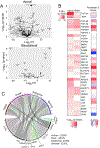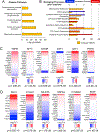Lack of CFTR alters the ferret pancreatic ductal epithelial secretome and cellular proteome: Implications for exocrine/endocrine signaling
- PMID: 34016558
- PMCID: PMC8595456
- DOI: 10.1016/j.jcf.2021.04.010
Lack of CFTR alters the ferret pancreatic ductal epithelial secretome and cellular proteome: Implications for exocrine/endocrine signaling
Abstract
Background: Cystic fibrosis (CF) related diabetes is the most common comorbidity for CF patients and associated with islet dysfunction. Exocrine pancreas remodeling in CF alters the microenvironment in which islets reside. Since CFTR is mainly expressed in pancreatic ductal epithelium, we hypothesized altered CF ductal secretions could impact islet function through paracrine signals.
Method: We evaluated the secretome and cellular proteome of polarized WT and CF ferret ductal epithelia using quantitative ratiometric mass spectrometry. Differentially secreted proteins (DSPs) or expressed cellular proteins were used to mine pathways, upstream regulators and the CFTR interactome to map candidate CF-associated alterations in ductal signaling and phenotype. Candidate DSPs were evaluated for their in vivo pancreatic expression patterns and their functional impact on islet hormone secretion.
Results: The secretome and cellular proteome of CF ductal epithelia was significantly altered relative to WT and implicated dysregulated TGFβ, WNT, and BMP signaling pathways. Cognate receptors of DSPs from CF epithelia were equally distributed among endocrine, exocrine, and stromal pancreatic cell types. IGFBP7 was a downregulated DSP in CF ductal epithelia in vitro and exhibited reduced CF ductal expression in vivo. IGFBP7 also altered WT islet insulin secretion in response to glucose. Many CFTR-associated proteins, including SLC9A3R1, were differentially expressed in the CF cellular proteome. Upstream regulators of the differential CF ductal proteome included TGFβ, PDX1, AKT/PTEN, and INSR signaling. Data is available via ProteomeXchange with identifier PXD025126.
Conclusion: These findings provide a proteomic roadmap for elucidating disturbances in autocrine and paracrine signals from CF pancreatic ducts and how they may alter islet function and maintenance.
Keywords: Cystic Fibrosis; Cystic Fibrosis Related Diabetes; ductal cells; pancreas; proteome; secretome.
Copyright © 2021. Published by Elsevier B.V.
Conflict of interest statement
Declaration of competing interest The authors declare no existing conflicts of interest.
Figures





Similar articles
-
CFTR Influences Beta Cell Function and Insulin Secretion Through Non-Cell Autonomous Exocrine-Derived Factors.Endocrinology. 2017 Oct 1;158(10):3325-3338. doi: 10.1210/en.2017-00187. Endocrinology. 2017. PMID: 28977592 Free PMC article.
-
The Potential Causes of Cystic Fibrosis-Related Diabetes.Front Endocrinol (Lausanne). 2021 Jul 30;12:702823. doi: 10.3389/fendo.2021.702823. eCollection 2021. Front Endocrinol (Lausanne). 2021. PMID: 34394004 Free PMC article. Review.
-
Abnormal endocrine pancreas function at birth in cystic fibrosis ferrets.J Clin Invest. 2012 Oct;122(10):3755-68. doi: 10.1172/JCI60610. Epub 2012 Sep 17. J Clin Invest. 2012. PMID: 22996690 Free PMC article.
-
Pancreatic and Islet Remodeling in Cystic Fibrosis Transmembrane Conductance Regulator (CFTR) Knockout Ferrets.Am J Pathol. 2018 Apr;188(4):876-890. doi: 10.1016/j.ajpath.2017.12.015. Epub 2018 Jan 31. Am J Pathol. 2018. PMID: 29366680 Free PMC article.
-
The cystic fibrosis of exocrine pancreas.Cold Spring Harb Perspect Med. 2013 May 1;3(5):a009746. doi: 10.1101/cshperspect.a009746. Cold Spring Harb Perspect Med. 2013. PMID: 23637307 Free PMC article. Review.
Cited by
-
Integrated Physiology of the Exocrine and Endocrine Compartments in Pancreatic Diseases: Workshop Proceedings.Diabetes. 2023 Apr 1;72(4):433-448. doi: 10.2337/db22-0942. Diabetes. 2023. PMID: 36940317 Free PMC article. Review.
-
CFTR represses a PDX1 axis to govern pancreatic ductal cell fate.iScience. 2024 Nov 15;27(12):111393. doi: 10.1016/j.isci.2024.111393. eCollection 2024 Dec 20. iScience. 2024. PMID: 39687022 Free PMC article.
-
Fatty acid abnormalities in cystic fibrosis-the missing link for a cure?iScience. 2024 Oct 11;27(11):111153. doi: 10.1016/j.isci.2024.111153. eCollection 2024 Nov 15. iScience. 2024. PMID: 39620135 Free PMC article. Review.
-
Cystic Fibrosis-Related Diabetes Workshop: Research Priorities Spanning Disease Pathophysiology, Diagnosis, and Outcomes.Diabetes Care. 2023 Jun 1;46(6):1112-1123. doi: 10.2337/dc23-0380. Diabetes Care. 2023. PMID: 37125948 Free PMC article. Review.
-
Cystic Fibrosis-Related Diabetes Workshop: Research Priorities Spanning Disease Pathophysiology, Diagnosis, and Outcomes.Diabetes. 2023 Jun 1;72(6):677-689. doi: 10.2337/db22-0949. Diabetes. 2023. PMID: 37125945 Free PMC article. Review.
References
Publication types
MeSH terms
Substances
Grants and funding
LinkOut - more resources
Full Text Sources
Other Literature Sources
Medical
Molecular Biology Databases
Research Materials
Miscellaneous

